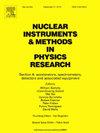Determination of the mass attenuation coefficient over a broad energy range based on the Rayleigh to Compton scattering ratio: Curve-fitting and machine learning methods
IF 1.5
3区 物理与天体物理
Q3 INSTRUMENTS & INSTRUMENTATION
Nuclear Instruments & Methods in Physics Research Section A-accelerators Spectrometers Detectors and Associated Equipment
Pub Date : 2025-04-21
DOI:10.1016/j.nima.2025.170555
引用次数: 0
Abstract
In this study, we present two novel methods for determining the mass attenuation coefficient over a broad energy range based on the Rayleigh and Compton scattering spectra collected by a Si(Li) detector. These methods involve developing either curve-fitting models or artificial neural network models to obtain (i) the relationship between the effective atomic number and the Rayleigh to Compton scattering ratio, and (ii) the dependence of the mass attenuation coefficient on both the effective atomic number and photon energy. Using these models, the mass attenuation coefficient can be calculated from input data consisting of the Rayleigh to Compton scattering ratio and photon energy. Next, we applied the proposed methods to 12 different materials, thereby confirming their accuracy. The results show that both methods offer equivalent accuracy. Specifically, within the energy range of 200 keV to 10 MeV, the mass attenuation coefficients determined by these methods exhibit relative deviations of less than 6 % when compared to XCOM (NIST) values. However, in the low-energy range of 50 keV–200 keV, the relative deviations can be significant for multi-element materials (reaching up to 43 %). Overall, these findings demonstrate the feasibility of our proposed methods as additional solutions for determining the mass attenuation coefficient of materials. Two notable advantages of these methods are that they can derive the mass attenuation coefficient across a broad energy range without requiring any information about the sample composition and that the data set used to fit the calibration curves or train the artificial neural network is generated via Monte Carlo simulations.
基于瑞利-康普顿散射比的宽能量范围内质量衰减系数的确定:曲线拟合和机器学习方法
在这项研究中,我们提出了两种基于Si(Li)探测器收集的瑞利和康普顿散射光谱在宽能量范围内确定质量衰减系数的新方法。这些方法包括建立曲线拟合模型或人工神经网络模型,以获得(i)有效原子序数与瑞利-康普顿散射比之间的关系,以及(ii)质量衰减系数与有效原子序数和光子能量的依赖关系。利用这些模型,可以根据瑞利-康普顿散射比和光子能量的输入数据计算质量衰减系数。接下来,我们将提出的方法应用于12种不同的材料,从而验证了它们的准确性。结果表明,两种方法具有相当的精度。具体来说,在200 keV ~ 10 MeV的能量范围内,用这些方法测定的质量衰减系数与XCOM (NIST)值的相对偏差小于6%。然而,在50 keV - 200 keV的低能量范围内,多元素材料的相对偏差可能很大(可达43%)。总的来说,这些发现证明了我们提出的方法作为确定材料质量衰减系数的附加解决方案的可行性。这些方法的两个显著优点是,它们可以在很宽的能量范围内推导质量衰减系数,而不需要任何关于样品组成的信息,并且用于拟合校准曲线或训练人工神经网络的数据集是通过蒙特卡罗模拟生成的。
本文章由计算机程序翻译,如有差异,请以英文原文为准。
求助全文
约1分钟内获得全文
求助全文
来源期刊
CiteScore
3.20
自引率
21.40%
发文量
787
审稿时长
1 months
期刊介绍:
Section A of Nuclear Instruments and Methods in Physics Research publishes papers on design, manufacturing and performance of scientific instruments with an emphasis on large scale facilities. This includes the development of particle accelerators, ion sources, beam transport systems and target arrangements as well as the use of secondary phenomena such as synchrotron radiation and free electron lasers. It also includes all types of instrumentation for the detection and spectrometry of radiations from high energy processes and nuclear decays, as well as instrumentation for experiments at nuclear reactors. Specialized electronics for nuclear and other types of spectrometry as well as computerization of measurements and control systems in this area also find their place in the A section.
Theoretical as well as experimental papers are accepted.

 求助内容:
求助内容: 应助结果提醒方式:
应助结果提醒方式:


